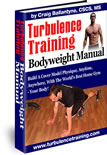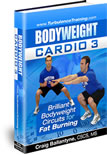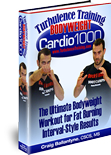20 Bodyweight Exercises for Fat Loss
 Try These Twenty BodyWeight Exercises for Maximum Fat Loss
Try These Twenty BodyWeight Exercises for Maximum Fat Loss
Most people are under the impression that they need to join an expensive gym or invest in fancy gadgets to get an effective exercise regimen. This could not be further from the truth. Using your own bodyweight for gaining strength, improving endurance and aiding fat loss is one of the most beneficial and economical workout programs to use. And the only thing you need to invest is your time—not your money.
Bodyweight exercises challenge you more than lifting and lowering weights. Those types of exercises will certainly improve strength and help you gain muscle, but not in the same way. This is because traditional weightlifting usually focuses on just one muscle at a time. When you perform bicep curls with weights, all that is working is your biceps. The same goes for many other weightlifting exercises. A standard bench press primarily works the chest although the shoulders and the triceps get a little something out of the deal as well, but the chest is the primary beneficiary of the exercise. But you are usually lying down when you do them which means your lower body is out of the equation.
Weight training definitely has its place and rewards, but when you are talking about fat loss, you will reap more benefits from using your own bodyweight as your exercise apparatus. Whether it is a cardiovascular exercise, a strength exercise or a core exercise, every single body weight movement focuses on using more than just one single muscle group which is why it is touted as the most effective for fat loss—your entire body needs to work in unison to perform (correctly) each and every exercise. While there are dozens of body weight exercises to choose from, here is a list of twenty highly effective ones for fat loss.
Upper Body –These exercises will focus mainly on the upper body, but still rely on many supporting muscles so you get more out of it than just a strong upper body.
Standard Push-ups: No one likes them, but everyone needs them. It is the most often used exercise in any training program and with good reason. Not only does it work all of your upper body including your chest, shoulders and triceps, but your core is also working as well to keep your body from sagging. To do a push-up, place your hands on the floor directly under your shoulders. Your feet are either together (more difficult) or set wide (easier) and your back is straight—no sagging hips and no butts sticking up in the air. Slowly bend your elbows, lowering your chest to the floor and then straighten your arms back up. That is considered one rep.
If you are unable to do a standard push-up, you can always modify it by coming off your toes and going onto the part of your leg just above your kneecap (never directly on the kneecap). Just make sure all your body weight is still in your upper body and your back is still straight. Once these become less challenging, make the transition to a regular push-up by starting out with only one knee down and go on your toes with the other. Like a standard push-up, remember to keep your abs tight and your body straight.
Decline Push-ups: These are a bit more challenging than regular push-ups because your range of motion will be much greater. You are basically starting in the same position as you would a standard push-up, but now your feet are elevated on top of a high bench, chair or stair. Lower your upper body to the ground and then push through your chest, shoulder and triceps to return to start. Make sure your abdominals are tight and your back stays straight throughout the movement.
Spiderman Push-ups: You may just feel like a superhero after mastering this exercise as it pushes your upper body and abdominal muscles harder than most push-ups out there. Start in standard push-up form and as you lower your chest to the floor, bring your right knee to your right elbow. This should be done in one smooth movement. As you lift your body up, bring your leg back to start. On the next one, switch legs bringing your left knee to your left elbow. Keep your back straight, abs tight and do not rotate your hips.
Shoulder Press Push-up: Here is a push-up that lets your shoulders do all of the work. Elevate your feet on a bench as you would in an elevated push-up, but bring your hands as close to the bench as you can. You will be in an inverted V position. Legs can be bent or straight. Lower your head to the floor and then use your shoulders, chest and triceps to push yourself back up.
Pull-ups: Pull-ups are what sometimes define a person’s strength as you are using all of your bodyweight. Grab on to a high bar with an overhand grip (make sure it is sturdy enough to support your weight) and then pull your body up as high as you can and then slowly lower back down.
Inverted Rows: If regular pull-ups are too difficult, inverted rows still give you a great back workout. Grab hold of a bar that is roughly waist height and place your chest under it while extending your arms and having your legs straight out so you are on your heels. Squeeze your abs, upper back and lats to pull your chest up to the bar and then slowly lower yourself back to start. If you want to make it more difficult, use one arm instead of two. To make it less challenging, keep your knees bent and your feet flat on the floor.
Lower Body – Your lower body has many active muscles that you use throughout the day. Just walking alone utilizes your hamstrings, quadriceps, glutes and calves. For this reason, working your lower body keeps these muscles strong so they can continue to support your daily movements as well as aiding in fat loss.
Squat: This is a lower body staple as it is the most basic of all the lower body exercises. With your feet a little more than shoulder width apart, abs tight, glutes squeezed and toes facing front, lower your body to the ground as far as you can while keeping your back straight and not allowing your knees to go beyond your toes. The best way to remember to do this exercise correctly is to push your hips back as if you want your butt to tap the top of a chair behind you. Most importantly, never round or arch your back—always keep it neutral. Push through your glutes, hamstrings and quadriceps to return to your starting position.
Prisoner Squat: This exercise is just like a regular squat but instead of letting your arms hang at your sides, place your hands behind your head. By doing this, you take out some of the momentum that you may find yourself using on a regular squat. You are also adding some weight by placing your hands above your body. Again, keep the same perfect form that you would in a traditional squat.
Y Squat: The Y squat is similar to the prisoner squat but your arms will be extended up and out forming a Y rather than behind your head. Keep your upper back and shoulders tensed, push your hips back and lower as far down as you can watching that your knees do not pass your toes and that your back does not round. Push through those glutes, quadriceps and hamstrings to return to your starting position.
Hip Extensions: Your hamstrings are one of the most important muscles of your leg. And just because you cannot see them does not mean they should not be worked. Hip extensions are a common and useful exercise for improving hamstring strength. Lie on the floor with your feet flat and knees bent. Squeeze your glutes and lift your hips off the floor. Make sure to not use your hips to lift. Hold the hips up for a second before lowering them back down so they are just above the floor but not touching it. You can make this more difficult by extending one leg up and out while you lift your hips.
Forward Lunge: Lunges are great exercises and highly effective when done correctly. To begin, stand with your feet shoulder width apart. Take a large step forward with your right leg and then bend that leg towards the ground while you are on your toes of your left foot. Make sure that your left knee also bends down to the floor. Your goal is to get your right thigh parallel to the ground without extending your knee passed your toes on the right leg. Do not bend over with your upper body. Keep your chest tall and your abs tight. To return to your starting position, push off the heel of your right foot back to a standing position. Switch legs after you completed a set on one side or you can alternate sides. The key is to remember to step forward and down rather than forward and forward.
Walking Lunge: Now that you mastered a forward lunge, you can add some movement to it. Rather than standing in one place and bringing your forward leg back to start, stay there and bring your other leg forward as if you were taking giant lunging steps.
Reverse Lunge: Who says you cannot go backwards when you lunge? This time from your starting position you want to take a step behind you with your leg and then lowering yourself to the ground as you would in a forward lunge only you are taking a step back rather than forward. The same rules apply—watch your front knee, bend the back knee to the floor and keep your chest up.
Cardiovascular Exercises -No fat loss workout is complete without some cardiovascular exercise. Here is where you will really elevate your heart rate and push your body to the max.
Jumping Jacks: Still an oldie but goody, jumping jacks are great as a warm-up exercise or as part of your fat loss routine. Stand straight with your arms at your sides. Jump your feet out wide while bringing your arms overhead and then return to start. Make sure you are on the balls of your feet when you do jumping jacks.
Burpees: Whether you love them or hate them, burpees will never fail you when it comes to cardiovascular exercise. Start in a standing position and then lower down so your knees are bent and your hands are on the floor. Kick your legs straight out behind you so you are in a standard push-up position and then jump them back in to your chest and then stand up. For a cardiovascular bonus, you can add a jump on the way back up to standing.
Step-ups: Here is a cardiovascular exercise disguised as a lower body one since your lower body will no doubt be working just as hard as your heart. Find a six-inch high step or bench to start and stand in front of it. Use your right leg and step up onto the bench with your left foot still on the floor. Now squeeze your glutes and push through your right foot to bring the left leg up. Hold it for a second and then lower back down. Do a set on the right leg before switching to the left. As this exercise becomes easier, start using a higher step or bench.
Mountain Climbers: This exercise works just about everything—your abs, your upper body, your lower body and your heart. Begin in a standard push-up position with your hands and shoulders lined up. Contract your abs and pull your right knee in towards your chest without letting your butt pop up or sag. Also, do not tap your toes to the floor when you bring your knee in. Return your right leg back to start and then do the same thing with the other leg and keep alternating. The faster you go, the higher your heart rate will get and your abs will feel it too.
Core Exercises -You do not want to lose all the fat and still have a big belly which is why any good fat loss workout incorporates working your abdominal muscles.
Plank: Lie down facing the floor and then come up onto your forearms making sure your elbows and shoulders are lined up, your back and body is straight and you are on your toes. Keep your abs tight and hold this position for as long as you can. For a modification, come down to a kneeling position rather than staying on your toes.
Side Plank: Similar to a plank, but instead of being on both forearms and facing down, you are on one forearm and facing the side. Lift your hips off the floor and hold the contraction in your obliques and abs. Switch sides once you are done. Again, you can modify this by keeping the knee of the bottom leg on the floor.
Knee-up: Here is where your abs will certainly feel the burn. Grab hold of a bar overhead and let your body hang down. Now slowly lift your knees up towards your chest. Make sure to use your abs to bring the knees up and not your hips. Lower your knees back down making sure you maintain a slow pace so your body does not rock back and forth.
Putting it All Together – The best way to make the most out of all of these exercises is to use them as part of a circuit or interval training program. You can mix it up any way you like. For example, you can do one upper body exercise, one lower body exercise, one core exercise and one cardiovascular exercise with no rest between. When you are done, take a few seconds to catch your breath and do it all over again. Try to get in six to eight circuits. The nice part is there are so many exercises to mix and match that you can have a different workout every time. This helps to keep you motivated and conquer boredom which is often a common reason people stop exercising.
Do not forget to always make sure you have proper form with every exercise and consider using the modifications if you cannot do them the more advanced way. It is always better to do them correctly in a modified way rather than struggling through an exercise that you are unable to do at all. Not to mention, you run the risk of injury if you perform exercises incorrectly.
You also do not want to forget about proper nutrition. Eating healthy and smart is part of any fat loss program and it will help you see results from your workouts even faster. Your body needs energy for your training so provide it with the proper fuel so you can go all out. And in no time, you will be winning the battle of the bulge with these bodyweight exercises.
Craig Ballantyne, CSCS, MS
Certified Turbulence Trainer